STAR Method Interview Response - Examples and Questions
What is the STAR method? You can utilize the STAR interview method to prepare for behavioral and situational interview questions. STAR is an acronym for situation, task, action, and result. Using real-life situations, this technique will assist you in preparing clear and succinct replies.
Behavioral interview questions are used by hiring managers to assess if you are the perfect fit for a position.
By employing the STAR method, you may ensure that you completely address the interviewer's question while also illustrating how you overcame and succeeded in the past.
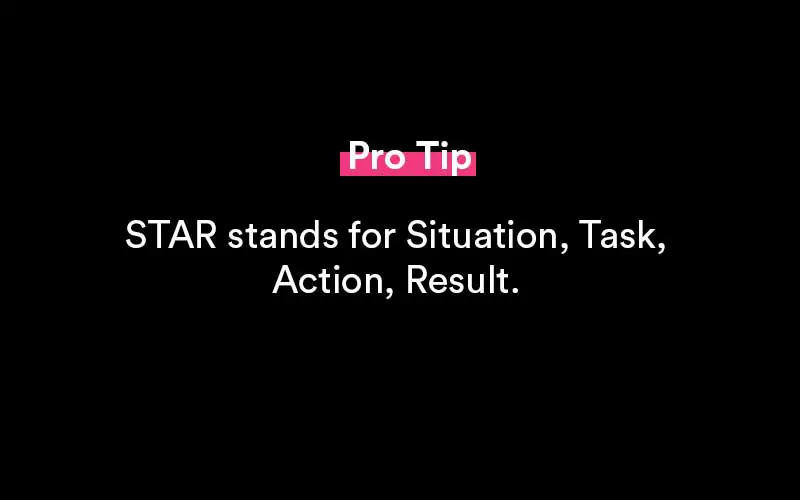
Why use the STAR method?
Answering behavioral interview questions using the STAR interview response approach. Behavioral interview questions are inquiries into your previous behavior. They are specifically about how you handled particular job circumstances.
Employers who use this method examine occupations and identify the abilities and traits that top performers have demonstrated in that position.
Because previous success may be a strong predictor of future performance, interviewers use these questions to see if candidates have the necessary abilities and experience to succeed in the position.
Employers may be looking for evidence of problem-solving abilities, analytical ability, creativity, tenacity in the face of failure, writing skills, presentation skills, teamwork orientation (interpersonal skills), persuasive skills, mathematical skills, or accuracy, for example.
The following are some examples of behavioral interview questions:
- Tell me about a time when you had to finish a task in a short amount of time.
- Have you ever gone above and beyond your normal responsibilities?
- What should you do if a team member refuses to finish his or her job quota?
The STAR method is used by some interviewers to arrange their questions. By structuring questions using the STAR method, interviewers can learn about workplace competencies.
Job seekers may, however, prepare for behavioral interview questions by using the STAR interview approach.
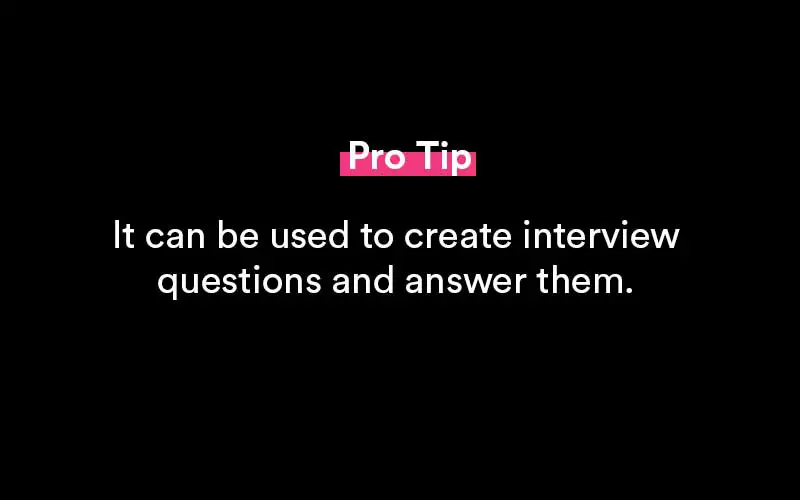
What is the STAR interview response method?
The term STAR stands for four essential ideas. Each idea is an action that a job applicant might take to respond to a behavioral interview question. The job candidate offers a complete solution by using all four procedures.
The acronym encompasses the following ideas:
Describe the situation in which you completed a task or encountered a problem at work. Perhaps you were working on a collaborative project or had a disagreement with a coworker. This scenario might be based on work experience, volunteer activity, or any other relevant experience. Make your statement as detailed as possible.
Next, explain the task. Perhaps you had to assist your team in completing a project on time, resolving a disagreement with a coworker, or meeting a sales goal.
The next step is to describe how you finished the assignment or attempted to overcome the problem. Instead of focusing on what your team, employer, or coworker accomplished, concentrate on what you did. (Tip: Say "I did ZYX" rather than "We did ABC.") Rather, the action.
Finally, describe the effects or outcomes that the activity produced. It may be beneficial to stress your accomplishments or lessons. The result.
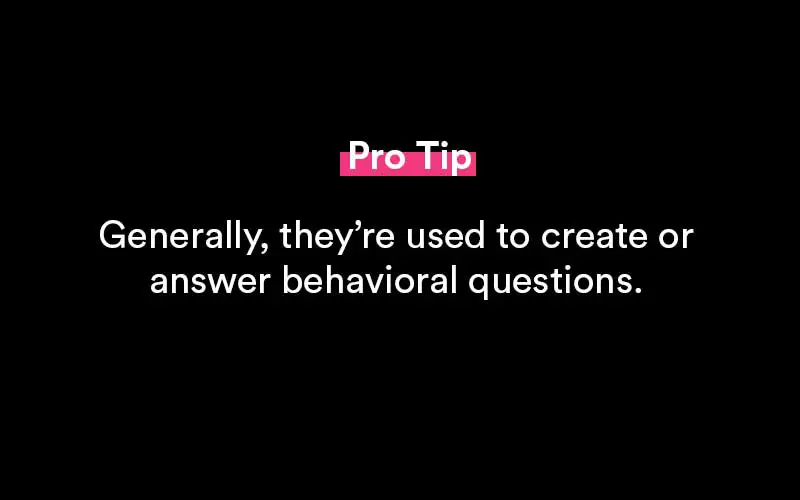
Why is the STAR method effective?
The STAR technique is effective in job interviews because it tells a story of a job situation, rather than simply answering the question. When a behavioral question is prompted to the interviewee, the hiring manager desires to learn the candidates competencies in the workplace.
STAR key concepts and how the STAR method works
Here is how the STAR method works.
Situation
Set the scene for the tale by describing the scenario or difficulty you faced. In most circumstances, it's ideal to explain comparable job scenarios, but depending on how much immediately transferable experience you have, academic projects or volunteer work may be suitable.
It's also critical to focus on a single situation rather than your overall duties.
Because interviewers are more interested in the activities you did and the outcomes you obtained, you should spend the least amount of time on this portion of your response.
By selecting the two or three most critical pieces of information needed to provide the interviewer with enough context about the issue, you may share the correct quantity of relevant material.
For example: “In my previous position as a project manager, there was a period when my team was understaffed and faced a huge backlog of work. The account managers were imposing unreasonable timelines on my staff, generating stress and lowering morale.”
Task
Describe your position or responsibilities in the scenario or problem. To put it another way, talk about the aim or duty you've been assigned.
This portion, like the scenario component, needs a small amount of time.
Consider only one or two points that best reflect the work you were assigned.
For example: “As a team leader, it was my responsibility not just to guarantee that my team fulfilled our deadlines, but also to convey bandwidth to other departments and keep my team motivated,” says one example.
Action
Describe the precise steps you took to deal with the problem or overcome the obstacle. This section of your response demands the most detailed explanation because it primarily determines your suitability for a position.
Choose a handful of the most important measures you took to achieve success and describe them.
Often, workplace problems are solved as a team; nevertheless, using the term "we" to explain how you met your objectives during an interview is a common blunder.
In any event, it's critical to concentrate on your actions in the circumstance.
It's important to remember that the company wants to recruit you for the job, not your team, therefore you should emphasize your individual contributions using the term "I."
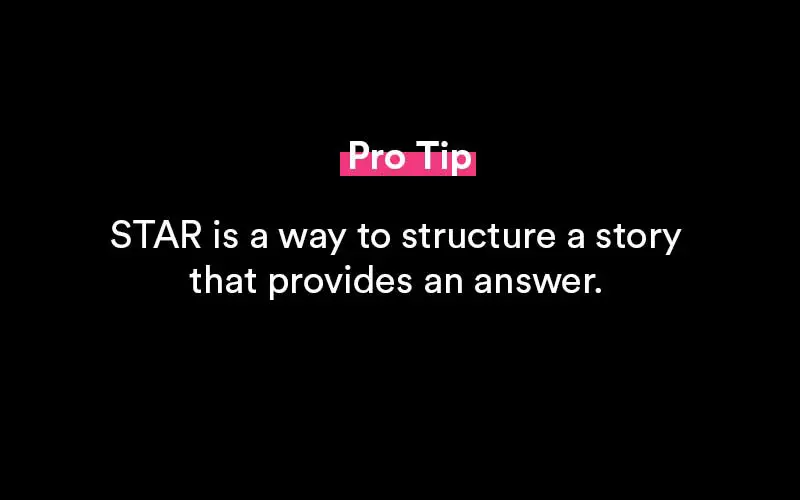
For example: “To create clearer expectations, I established a formal creative request procedure that included project timeframe estimates. Weekly meetings with account managers were arranged to discuss my team's bandwidth and provide progress reports. I also kept my staff updated on the new procedures so they could be certain that the problems were being addressed.”
Result
What result did you get as a result of your actions? This is also an essential aspect of your response that you should concentrate on. You should devote somewhat less effort to explaining the outcomes than to detailing your activities.
Decide on two or three of the most impressive findings and discuss them.
If feasible, quantify your achievements or offer tangible instances of the results of your work.
Also, talk about what you learned, how you developed, and how the experience has made you a better employee.
For example: “We were able to re-prioritize the design team's to-do list and complete everything in our backlog by providing more transparency into my team's processes and setting better expectations with the account managers by providing more transparency into my team's processes and setting better expectations with the account managers. I took these lessons and applied them to the structure, and as a consequence, we were able to reduce our average project timetable by two days in the next quarter. I also realized how critical it is to communicate well across teams.”
STAR interview question examples
Behavioral interview questions that can be answered utilizing the STAR method.
Use the STAR method to structure a verbose response.
- Give an example of a moment when you had to deal with a challenging situation at work. How did you come up with a solution to this issue?
- Have you ever had to make a decision that was unpopular? How did you deal with it?
- Describe a period when you were working under a lot of stress. What was your reaction?
- Tell me about a time when you committed a mistake. How did you deal with it?
- Give an example of a moment when you had to make a tough choice. What exactly did you do?
- Explain an instance in which you made a suggestion based on facts or reasoning.
- Tell me about a moment when you and your employer had a disagreement. How did you come up with a solution?
- Give me an example of when you had to make a fast decision under pressure.
- Describe a time that you witnessed colleagues doing something incorrectly. And what you did about it.
- Describe a moment when you had to break the terrible news to someone. How did you pull it off?
- Tell me about a moment when you collaborated with people from other departments to finish a job.
- Give an example of a moment when you were unsuccessful. What did you take away from the encounter?
- Tell me about a moment when you set a goal and achieved it.
- Tell me about a moment when you had to persuade someone to do something you didn't want them to do.
- Describe a situation in which you had a disagreement with a coworker. How did you deal with it?
- Have you ever had to persuade someone to do something? How did you pull it off?
- Tell me about a time when your workday ended before you completed all of your tasks.
How to prepare using the STAR method
While you won't know the interview questions ahead of time, most behavioral interviews will focus on a variety of work-related problems that need critical thinking and problem solving, as well as scenarios that indicate leadership, conflict resolution, and performance under pressure.
What are behavioral interview questions?
Behavioral questions are used by interviewers to discover how you have acted in past job settings.
Employers are searching for instances of your prior behavior in your replies that might indicate how you'll respond in similar situations in the future.
These questions are more open-ended than a yes-or-no question, and they typically invite you to share tales or instances from past employment.
General steps to prepare
Here are the steps to prepare for your upcoming interview.
- Examine the job description and needed abilities, then think about what kinds of problems or barriers you could face in the role.
- You should also go over some of the most frequent behavioral interview questions, such as the ones listed above. While the exact wording of these questions may differ from one interview to the next, the basic aim of the question is usually the same, so it's a good idea to prepare your responses with that in mind. For example, the interviewer may inquire about “a moment when you were under pressure,” or “how you deal with stress.” In any case, their objective is to learn how you handle difficult circumstances.
- Make a list of the numerous circumstances you've dealt with in your professional life that demonstrate the kind of skills you'll need to succeed in the position and that answer some of the most frequent behavioral interview questions. Use the STAR framework to prepare each example.
- Make sure each narrative is as concise and logical as possible by talking through your replies aloud. When giving responses in an interview, this will also make you feel more confident and natural.
Consider examples from internships, volunteer work, or group projects you performed for school if you're fresh to the field and don't have a long professional background to draw on.
Employers may ask you to provide a non-work-related example in certain situations, so think about problems or barriers you've faced in your personal life as well.
STAR method interview answers (examples)
Situation, Task, Action, Result method. The STAR interview method. Interview questions and answers utilizing this response format in a job interview.
Example answer 1
An example job interview answer using the STAR response.
Situation
When there are team disagreements or difficulties, I always do my hardest to step in and lead the team if necessary.
Task
My communication abilities, I believe, make me a good leader and moderator. When I was working on a team project, for example, two of the team members got into a disagreement and refused to finish their assignments.
Action
They were both unsatisfied with their workloads, so I convened a team meeting in which we redistributed all of the team's responsibilities.
Result
Everyone was happier and more productive as a result, and our project was a success.
Example answer 2
An example job interview answer using the STAR response.
Situation
Last winter, I worked as an account coordinator at an ad agency, assisting the account executive for a large client. Three weeks before a major campaign pitch, the account executive was involved in an accident and was forced to take time off.
Task
I stepped in to fill in and manage the presentation by coordinating the creative and media teams' contributions. I convened an emergency meeting and conducted a discussion regarding ad scenarios, media strategies, and the various team members' duties in connection to the presentation.
Action
I was able to bring the team together on two key ad concepts that we needed to propose, as well as associated media plans. Based on our conversations, I set out a minute-by-minute strategy for how we would deliver the pitch, which was well welcomed by the team.
Result
Our strategy was well received by the customer, and the campaign was implemented. Six months later, I was promoted to account executive.
Example answer 3
An example job interview answer using the STAR response.
Situation
While I prefer to plan out my work in stages and execute it one at a time, I can also produce high-quality work under time constraints. At one of my previous employers, an employee departed only days before a project's deadline.
Task
With only a few days to learn about and complete the project, I was expected to take responsibility for it.
Action
I formed a task force and distributed tasks.
Result
We all finished the job on time. In fact, I feel I do best while working under pressure.
Remember, questions and answers using the STAR method are for demonstration purposes, only.
STAR response tips
Best STAR response tips.
Be prepared
Not only will having a good collection of STAR targeted success stories make answering them easier for you, but it will also help you emphasize to the hiring manager the unique traits and talents that make you suitable for the job and set you apart from the other applicants.
Be precise
It's not about being vague and wishy-washy with the STAR Method. Being prepared goes hand in hand with this. You should have identified the abilities and traits the employer is seeking prior to the interview. Make sure your tales are targeted and focused. Remember that the behavior that the hiring manager is looking for should be highlighted, and your success story should clearly connect with that.
Use numbers
Hiring managers are obsessed with data, so be sure you have strong, measurable accomplishments to back up your claims. Did your department's sales grow by 22%? Wherever feasible, back up your accomplishments with actual data and figures.Stay concise
Keep your story succinct, to-the-point, and focused. Try to keep your response to 90-seconds.
Stay honest, practice, and ask for feedback
Be honest with your response. Stay positive. Practice. And ask for feedback.
How to create a STAR method resume
Look at a job description and pick two to three essential behaviors or abilities to include in your "Experience" part of your resume utilizing the STAR technique.
Condense a potential response into a few important elements/bullets under the job title using the outline of a verbal response.
The easiest approach to accomplish this is to use one or more bullet points that clearly define all of the STAR answer's components.
Use the STAR technique to explain each position with your circumstances, a task or tasks you performed in that capacity, actions you took to reach a successful conclusion, and the consequence of those activities, rather than just listing essential duties for a prior work under your "Experience" section.
Each point may be summarized in a single statement or phrase.
Why use the STAR method on a resume?
In a resume, the STAR technique makes it easier to communicate the extent of your abilities and credentials.
The following are the primary advantages of using this method:
- Shows your worth: A potential employer's major aim is to figure out how you will bring value to the firm if you are employed. When you apply the STAR technique in your resume, you may more clearly demonstrate your worth.
- Provides more information: The STAR approach transforms a bulleted list's imprecise skill descriptions into a concrete example of how you acquired and used an important talent.
- Creates conversation starters: The STAR approach for writing a resume prepares you for an interview. Your resume/CV might serve as a guide for interview questions about your qualifications for the position.
- It tells a story: You may use the STAR technique to tell a story about how your job experience has shaped who you are.
- Produces a CV/resume that is competitive: You may link your STAR replies to an employer's job description using this technique. This not only demonstrates that you're qualified for the job, but it also makes a resume more fascinating to read.
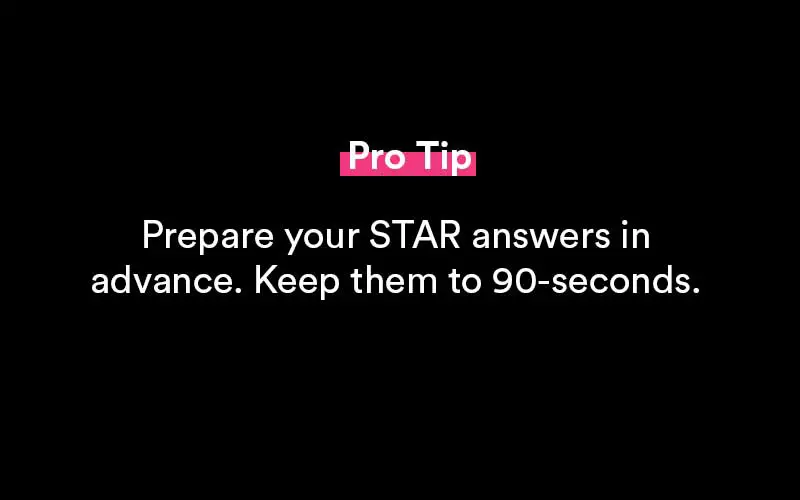
Popular Resources

Featured
35+ Phone Interview Questions & Best Sample Answers
Phone interviews have become a core part of the process when attempting to find a secured placement for an open position. Companies receive massive responses from potential candidates for any..

Featured
12+ Best Questions To Ask A Recruiter
Concerning a job search, you might receive numerous offers from your recruiters. Before you choose one, you need to assess all the conditions, for which it is vital that you know everything associated with the offered position..

Featured
Answering "What Makes You Unique" In A Job Interview
Answering this question during a job interview requires more than knowing why you are unique as an individual. Yes, the true scientific answer is made up of two main components: your..

Featured
250+ Ice Breaker Questions for Life
An ice breaker question is a question that’s asked from one person to another person in order to act as a conversation starter. It brings a connection...

Featured
10 Best Answers to "What Motivates You?"
Open-ended questions like “What motivates you?” can elicit a deer-in-the-headlights reaction from job candidates if they are unprepared. It’s a broad question and can leave the interviewer..

Featured
Answering "How Did You Hear About This Position" In An Interview
A lot of interviewers ask this question - how did you hear about this position? This way they can judge you if you are a passive or an active job seeker..

Featured
8 Best Thank You Emails After an Interview (Samples, Free Templates)
Writing a thank you note after an interview says a lot about you as a potential employee. Most notably, it says that you care about the opportunities presented..

Featured
Writing a Resignation Letter (How To Write It, Samples)
Writing the perfect letter of resignation is more of an art than it is a science. And we’re going to cover how to master that art form in this full guide..

Featured
How to End a Letter (Example Salutations, Sign Off's)
Knowing how to end a business note or email is an important skill to develop. It helps portray a sense of confidence, respect and tone to your message..
